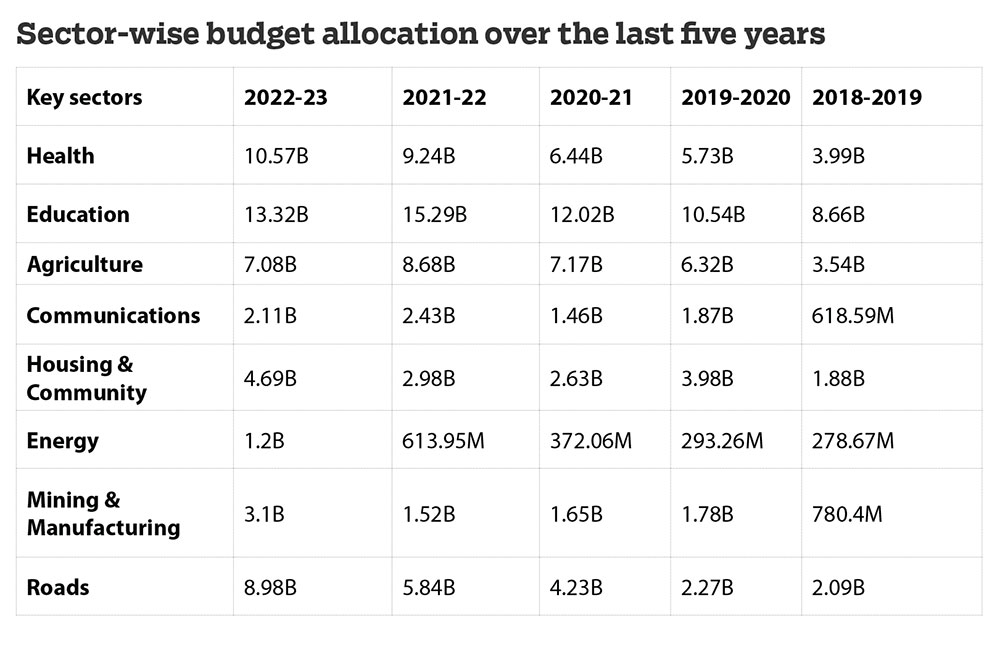Thukten Zangpo
The budget allocation for the fiscal year 2023-24 will be revealed only after the finance minister introduces the National Budget Report, Budget Appropriation Bill, and Supplementary Bill before the Parliament.
The Third Parliament’s ninth session is tentatively set to begin on June 8. The fiscal year 2023-24 will be the 12th Plan’s final year.
Bhutan being one of the few countries that provide free healthcare and education, the social sector (education and health) has gotten the most funding over the years.
In the last five years, the social sector received around 30 percent of the overall budget.
In this fiscal year 2022-23, the government has allocated Nu 23.89 billion (B) which corresponds to 29.2 percent of the total budget of Nu 81.83B for the social sector, second only to the economic and public sectors.
Budget allocation in the education sector climbed steadily from Nu 8.66 billion in the fiscal year 2018-19 to Nu 13.32 billion in the fiscal year 2022-23. It was a Nu 4.66 billion rise.
The education budget for 2022-23 is primarily focused on education reforms to boost STEM education, early childcare development, and ICT in schools for learning recovery and improved access.
Similarly, the health sector budget increased from Nu 3.99 billion in 2018-19 to Nu 10.57 billion, or 12.7 percent of the entire budget, in 2022-23.
The health budget for 2022-23 was primarily focused on buying Covid-19 vaccines (Nu 432.57 million), Covid-19 test kits (Nu 73 million), and flu clinics (Nu 32.55 million).

The health budget was also given for the construction of hospitals, and well-being hospital, Pema Centre, Gyaltsuen Jetsuen Pema Mother and Child Hospital, and Mongar Mother and Child Hospital.
The economic and public sectors obtained the largest share of the budget in the fiscal year 2022-23, with Nu 27.16 billion or 33.2 percent respectively of the entire budget.
The agriculture sector’s allocation more than doubled in the last five years, but in the fiscal year 2022-23, it fell by Nu 1.6 billion to Nu 7.08 billion from the previous year. The sector employs over half of all Bhutanese.
Energy sector’s allocation increased by nearly five times to Nu 1.2 billion in the current fiscal year from Nu 278.67 million in the fiscal year 2018-2019, mining and manufacturing to Nu 3.1 billion from Nu 780.4 million, and road construction to Nu 8.98 billion from Nu 2.09 billion, among others.
The Government of India has allotted Nu 24 billion for this fiscal year, a little increase from Nu 22.66 billion in the previous fiscal year.
The ambitious 13th Plan is set to commence in July 2024. The Plan is divided into two parts: the next five years and a 10-year period which includes projects that will continue after the 13th Plan.
The government intends to double the country’s GDP from USD 2.5 billion to USD 5 billion by 2029 and USD 10 billion by 2034.
According to projections from the former Gross National Happiness Commission, the government will need to mobilise between Nu 750 billion and Nu 1,250 billion in the 13th Plan.
According to the Asian Development Bank, a USD 10 billion economy would imply an annual real GDP growth rate of 10 percent from 2021 to 2030, which is greater than the average 5.4 percent growth rate from 2011 to 2019. By 2030, the target per capita income would be USD 12,375.
“To achieve the goal, the government will need to invest at least Nu 2 trillion, with the public sector expected to account for 15 percent of the estimated investment,” the ADB noted.
Agriculture is predicted to account for 10 percent by 2030 from 19.2 percent in 2020; industry 45 percent, up from 34.4 percent in 2020; manufacturing 15 percent, up from 6 percent in 2020; and services 45 percent from 46.4 percent in 2020.


